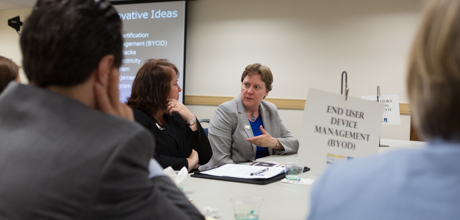Innovative cost-saving ideas—including a full scholarship that would be awarded to a student who develops an implementable plan to net the university $1 million—were the focus of a Showcase of Ideas Tuesday as part of George Washington University’s Innovation Task Force.
The seven leading ideas of the sixth phase of the ITF were unveiled at a Foggy Bottom showcase in the Marvin Center. A similar showcase will be held on April 25 on the Virginia Science and Technology Campus. Six of the ideas will be chosen to be presented to George Washington President Steven Knapp and senior administrators for final selection, followed by implementation planning in the next fiscal year.
The seven proposals included:
ITF Student Scholarship: A full scholarship would be awarded to a GW student (or shared among several students) who can develop a feasible plan to net at least $1 million for the university, either through savings or new revenue opportunities core to GW’s mission. Competition for the scholarship would be modeled after the university’s successful Business Plan Competition.
Regulatory Training Certificate: The university would offer a workshop or continuing education training program for attorneys and senior executives in technical professions on compliance-related topics.
End User Device Management: Nicknamed “BYOD” or “Bring Your Own Device,” this plan would optimize management of mobile phones, tablets and computers, allowing university employees freedom of choice in the devices they use and offering a stipend to cover device costs.
Eliminate Chargebacks: A chargeback occurs when a university department provides a service or goods to another unit and then seeks to recover the costs related to the transaction. Processing these transactions is time-consuming and can be expensive. While not all chargebacks can be eliminated, many can be.
Renewable Energy: The university would negotiate renewable power purchase agreements, locking in low rates on energy and working toward its long-term sustainability goals in the Climate Action Plan.
Mail Management: GW would seek to reduce paper mail and move most university mail to electronic-only formats.
Onsite Master’s Program with Partners: GW would expand partnerships with other institutions and organizations and customize course content.
The potential for an ITF student scholarship generated much interest among participants at the Showcase of Ideas.
“A scholarship competition like this would appeal to a wide array of students,” said Peter Konwerski, senior associate provost and dean of student affairs.
The “BYOD” idea would be appealing to many employees who now juggle two devices—one issued by the university and one for personal use, said Hank Molinengo, associate dean for administrative affairs at the Law School and member of the ITF Exploration Committee. In addition to allowing personal preference in selecting a device, the plan would free the university from long-term contracts with device manufacturers. Questions of security and software support would need to be answered, but similar plans have been successful elsewhere, he said.
David Lawlor, senior associate vice president for finance and chair of the ITF Steering Committee, said that while the cost savings generated by ITF are important, the larger benefits are intangible.
“We’re changing university culture, and people are thinking differently about what we can do as a university,” he said. “There’s very little discussion today about the obstacles and all the ways we can’t do things….people are results-oriented and committed to making things happen.”
The Innovation Task Force was established by President Knapp in October 2009 with the charge of generating $60 million in annual, recurring savings and new revenue for reinvestment in the university’s top academic priorities. Six new innovation ideas are selected for implementation every six months. To date, 60 initiatives and approximately $56 million have been identified toward the $60 million goal.


